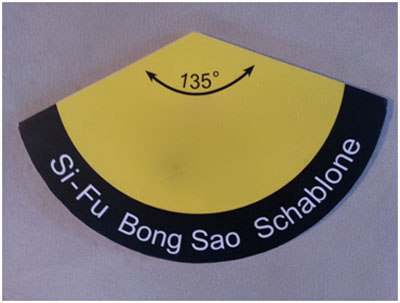The optical illusion: why does the modern WingTsun of the EWTO look different?
In his guest editorial Dai-Sifu Oliver König addresses the frequent question whether we are now doing something different from "traditional WingTsun", or indeed whether we still do WingTsun in the EWTO at all. And also whether what we do can work effectively at all.
These questions are mostly posed by outsiders or even raised as criticisms, e.g. in forums or in comments on videos. But students who have not been active for a few years also find that there have been fundamental changes in the approach of the EWTO.
A technique or a process
At all times the EWTO has followed the principle that life means constant change. For this reason further development is absolutely essential to counter stagnation and rigidity. In the lower programmes one tends to look at the techniques and create images of them in one's mind. A BongSao is e.g. seen as a technique with a 135° angle of which a snapshot can be taken. The beginner needs such images in order to create a structure of ideas. He learns basic techniques that give him a rudimentary, greatly simplified picture that provides him with orientation.
In contrast to this, the advanced student does not look at the individual technique, but rather the process and its function. For the advanced student the BongSao is an arm that is deformed by the opponent's pressure and gives him tactile information about how to take avoiding action with the body, free the arm and use it for a counter-attack. This overall process cannot be captured in a photograph (as a technique), but at most as a film sequence. The angle of the arm changes constantly in the process. It does not dwell at a specific angle, otherwise it would become a block and the opponent's power would not be redirected.
So those who criticise that this or that position is incorrect have remained at the beginner level, or are still practicing the 1980s WingTsun of the EWTO.
A process that follows the WingTsun principles
It is not the individual techniques that characterise WingTsun, but rather the superordinate principles:
-
Stay in contact with what comes!
-
Accompany home what withdraws!
-
If the way is clear or your arm loses contact, thrust forward!
If it looks like WingTsun, it is not WingTsun!
As movements obeying the above principles are always adapted to the prevailing situation, they cannot always look the same. The opponent attacks at different angles, the direction of pressure varies, the height of the attack can differ and the attack may be linear or curving etc.
So those who apply prefabricated techniques are already not working according to WingTsun principles, as they have to "make things suit" that do not suit.
Here is an example: If I insist on executing a Bong with an angle of
|
|
|
|
|
Illustration: outdated model: No joke, the BongSao template was used to make sure that the student held his BongSao at a 135° angle. We now see this as counter-productive if one wishes to give way softly when defending. |
135° and the opponent applies pressure against my Bong, I can of course compensate by using my strength. Instead of redirecting his power and removing the target, I can increase my own pressure to maintain the angle – those who want to practice a power-oriented Wing Tsun (not the WingTsun of the EWTO!) are welcome to do this, just as many other Wing-Tsun styles (Wing Chun, Ving Tsun etc.) do, but to "make the technique work" they need more strength than the opponent.
I like to demonstrate this in seminars, as I am able to adopt this approach against most of my students by virtue of my size, physical strength and speed: I shove a "stiff Bong" at the attack and overwhelm the student with chain-punches. I then ask a student who is obviously physically weaker than I to do the same to me. The result is either that he flies all over the place owing to his stiff Bong, or the Bong collapses and my punch strikes home.
As there is a relatively low chance of being attacked by a smaller, less strong opponent in a real confrontation, this approach is also poorly suited for self-defence.
Most of our competitors who work in this fashion tend to have teachers with above-average strength who emphasise power training in their classes.
WingTsun is in continuous further development
One reason why the WingTsun of the EWTO looks very different today from that of the 1980s is its adaptation to real self-defence situations. In the course of his investigations, GM Kernspecht found that most physical confrontations do not begin from a distance as in sporting competition, but rather at very short distances. This and the fact that curving attacks (hooks, haymakers) are used in more than 90 % of cases led us to adapt our training methods accordingly within the EWTO.
Anybody trying to practice ChiSao at a short distance with and against curving attacks will find that it is essential to move the torso as well, modify the stance etc. – which makes WingTsun look different, but the same principles are applied!
Two concepts: linear and curving
It is often overlooked that in yin-yang fashion, there are also two concepts contained in traditional WingTsun: the linear or straight-line WingTsun concept (SiuNimTau and ChamKiu forms) and the curving or rounded WingTsun concept (BiuDze and Double-knives forms). It used to be that the first concept was practiced to excess, while neglecting the second concept. Owing to the traditional learning sequence, students trained with linear attacks and a rigid torso for years. When it was time to learn the BiuDze form, this conditioning meant that the student was no longer able to deform his torso flexibly and absorb the idea of curving attacks.
The linear and curving WingTsun concepts might be seen as two different tools that can be used depending on the problem. Both have a justified existence, and both are included in the modern EWTO teaching programmes from the start. The student does not need to wait until he progresses to the BiuDze or Double-knives form, but performs the movement sequences he needs to solve the relevant problem in the programme concerned.
Why a linear attack is not automatically better than a curving one
Many WingTsun followers believe that a linear attack is preferable to a curving attack. The reason given is usually that the path taken by a linear attack is shorter, and therefore faster than that of a curving attack. What this fails to take into account is that it depends on the situation at hand.
- If the way is blocked for a linear attack, a curving attack is usually the best solution to the problem.
- If I am standing at an angle to the opponent, a linear attack is usually not the best solution. The opponent only needs to raise his shoulder and retract his head a little, then my linear attack will not strike home. A curving attack will almost always hit the target, however.
- There are cases where a curving attack is faster than a linear attack. This is know as 'brachistochronous' by scientists. The shorter path is not always the faster!
- Preferably using protective equipment, anybody can try out whether he is able to prevail against an opponent delivering curving attacks by applying linear attacks (chain-punches). The opponent delivering curving attacks usually moves his head, providing no fixed target, and lengthens his range by extending his shoulder. Sometimes he will move back slightly as he delivers his curving attack, and many WingTsun people have had problems with this in the past!
Keeping to the centre-line
Another myth that is usually misunderstood by beginners. Many believe that they must attack along the centre-line. This has been instilled in them by generations of teachers, and is obeyed with almost religious zeal. Admittedly, there are sometimes situations where it is best to punch close-in, along the centre-line.
Usually the centre-line is occupied, however, which means that you come up against the opponent's guard. Many of the defences in traditional WingTsun actually only work because the opponent sticks to the rule of keeping the elbow close and punching along the centre-line.
The centre-line has its value, of course. However, it does not show you which path your attack should slavishly take, but rather how you should "position yourself relative to the opponent's inner "candle-wick". Those who have understood this small difference are already well on the way to mastering WingTsun.
For those wishing to find out more about the working principle of modern EWTO WingTsun, I recommend the new book by my SiFu, GM Prof. Keith R. Kernspecht, "The Essence of WingTsun – Beyond techniques and applications".
Text and photo: DaiSifu Dr. Oliver König





